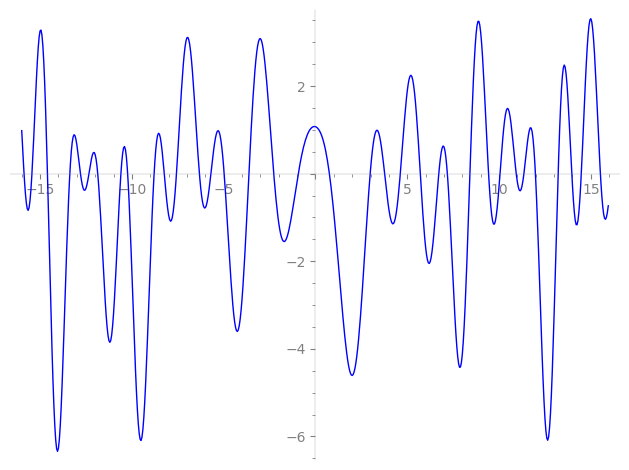| L(s) = 1 | + (−1.12 − 1.31i)3-s + (−0.927 − 1.60i)5-s + (−0.900 + 2.48i)7-s + (−0.467 + 2.96i)9-s + (−1.28 + 2.23i)11-s + (2.82 − 4.88i)13-s + (−1.07 + 3.03i)15-s + (3.57 + 6.19i)17-s + (−0.636 + 1.10i)19-s + (4.28 − 1.61i)21-s + (0.120 + 0.208i)23-s + (0.777 − 1.34i)25-s + (4.42 − 2.71i)27-s + (0.923 + 1.59i)29-s + 2.99·31-s + ⋯ |
| L(s) = 1 | + (−0.649 − 0.760i)3-s + (−0.414 − 0.718i)5-s + (−0.340 + 0.940i)7-s + (−0.155 + 0.987i)9-s + (−0.388 + 0.672i)11-s + (0.782 − 1.35i)13-s + (−0.276 + 0.782i)15-s + (0.868 + 1.50i)17-s + (−0.146 + 0.252i)19-s + (0.935 − 0.352i)21-s + (0.0251 + 0.0435i)23-s + (0.155 − 0.269i)25-s + (0.852 − 0.523i)27-s + (0.171 + 0.297i)29-s + 0.537·31-s + ⋯ |
Λ(s)=(=(1008s/2ΓC(s)L(s)(0.964+0.262i)Λ(2−s)
Λ(s)=(=(1008s/2ΓC(s+1/2)L(s)(0.964+0.262i)Λ(1−s)
| Degree: |
2 |
| Conductor: |
1008
= 24⋅32⋅7
|
| Sign: |
0.964+0.262i
|
| Analytic conductor: |
8.04892 |
| Root analytic conductor: |
2.83706 |
| Motivic weight: |
1 |
| Rational: |
no |
| Arithmetic: |
yes |
| Character: |
χ1008(625,⋅)
|
| Primitive: |
yes
|
| Self-dual: |
no
|
| Analytic rank: |
0
|
| Selberg data: |
(2, 1008, ( :1/2), 0.964+0.262i)
|
Particular Values
| L(1) |
≈ |
1.072732764 |
| L(21) |
≈ |
1.072732764 |
| L(23) |
|
not available |
| L(1) |
|
not available |
L(s)=p∏Fp(p−s)−1 | p | Fp(T) |
|---|
| bad | 2 | 1 |
| 3 | 1+(1.12+1.31i)T |
| 7 | 1+(0.900−2.48i)T |
| good | 5 | 1+(0.927+1.60i)T+(−2.5+4.33i)T2 |
| 11 | 1+(1.28−2.23i)T+(−5.5−9.52i)T2 |
| 13 | 1+(−2.82+4.88i)T+(−6.5−11.2i)T2 |
| 17 | 1+(−3.57−6.19i)T+(−8.5+14.7i)T2 |
| 19 | 1+(0.636−1.10i)T+(−9.5−16.4i)T2 |
| 23 | 1+(−0.120−0.208i)T+(−11.5+19.9i)T2 |
| 29 | 1+(−0.923−1.59i)T+(−14.5+25.1i)T2 |
| 31 | 1−2.99T+31T2 |
| 37 | 1+(−0.338+0.585i)T+(−18.5−32.0i)T2 |
| 41 | 1+(0.733−1.27i)T+(−20.5−35.5i)T2 |
| 43 | 1+(4.14+7.17i)T+(−21.5+37.2i)T2 |
| 47 | 1−12.3T+47T2 |
| 53 | 1+(−3.35−5.81i)T+(−26.5+45.8i)T2 |
| 59 | 1+2.08T+59T2 |
| 61 | 1−12.9T+61T2 |
| 67 | 1−4.83T+67T2 |
| 71 | 1−1.53T+71T2 |
| 73 | 1+(6.55+11.3i)T+(−36.5+63.2i)T2 |
| 79 | 1−3.72T+79T2 |
| 83 | 1+(−3.00−5.19i)T+(−41.5+71.8i)T2 |
| 89 | 1+(−6.60+11.4i)T+(−44.5−77.0i)T2 |
| 97 | 1+(−6.40−11.1i)T+(−48.5+84.0i)T2 |
| show more | |
| show less | |
L(s)=p∏ j=1∏2(1−αj,pp−s)−1
Imaginary part of the first few zeros on the critical line
−10.23070812237892164639764897211, −8.788919534544587309139373230099, −8.236338197105008065509163206762, −7.57146109022385378779603514328, −6.32144662689006173621269742320, −5.69422413997251172668490863086, −4.97341887483639272168638670029, −3.62407396109202787745775841484, −2.27214822539353163513701939871, −0.934849982196174165786965915114,
0.75806167273809316065007213949, 2.98088058270800704184233906465, 3.76774369150015926409338146360, 4.62110420260357015130031112208, 5.71111645069640655938642506160, 6.71839190780547668043738630972, 7.18435727380486293873498017040, 8.413018492406314468682201770666, 9.430208859531889475971648029384, 10.05456265511147264236107887122

